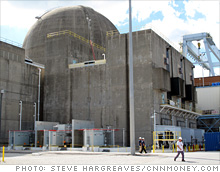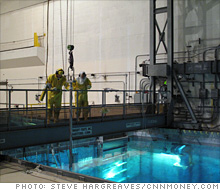Nuclear renaissance -- not dead yet
The industry is poised to get billions in federal help, but some say that's a bad idea.
 |
| One reactor at the Texas plant. The company wants to build two more in what could be the first expansion of nuclear power in the United States in 30 years. |
 |
| NRG energy CEO David Crane. NRG is the largest shareholder in the Texas plant. |
 |
| Nuclear waste is currently stored on site at power plants, like at this spent fuel pool at the Texas plant. Critics say a solution for nuclear waste should be found before any new plants are built. |
NEW YORK (CNNMoney.com) -- Whatever happened to all those new nuclear power plants the country was supposed to build?
Last year, with energy prices soaring and global warming making headlines, talk of a so-called "nuclear renaissance" was rampant. Energy experts, utility heads, even presidential candidates called for the construction of dozens of new plants. Billions were going to be spent. Investing magazines ran stories on how to get in on the action.
Then the credit crisis struck, energy prices collapsed, and the Democrats won the White House. Nuclear renaissance seemed all but dead.
But it's not dead, it's just on life support. As the greenhouse gas bill moves through Congress, billions more in taxpayer money could soon be deployed to resuscitate the movement.
Supporters say that's essential to jumpstart a clean, dependable source of power. Critics say it will keep the country reliant on a dangerous and expensive technology.
A hundred miles southwest of Houston, amid the refineries and petrochemical plants that dot Texas' Gulf Coast, construction on one of the first nuclear plants to be built in this country in the last 30 years could begin soon.
Leading the charge to make that happen is David Crane, the affable chief executive of New Jersey-based power producer NRG Energy (NRG, Fortune 500).
Standing on the wind-whipped edge of a massive man-made reservoir, Crane lays out the case for more nuclear power.
"What's important is what you don't see here," he said, pointing to the two existing nuclear reactors just behind the reservoir, which is used to cool the plants. "There's no smokestack. This is the green solution the country's energy needs."
Crane wants to build two more reactors at this site, doubling its electricity output to 5,400 megawatts -- or enough to power 4 million homes.
But to do that he needs government help. While nuclear plants are cheap to run once they're built, the construction costs are huge. Crane's two new plants are expected to cost at least $10 billion. And with a history of cost overruns and today's loan-wary bankers, he knows Wall Street isn't likely to give him the money. So he's hoping for a loan guarantee from the federal government, trying to get his hands on part of $18 billion in guarantees for nuclear power that lawmakers passed as part of the 2005 energy bill.
Like a lot of people pushing nuclear power, he makes his case largely on the fact that nuke plants don't emit any carbon dioxide, the main gas behind global warming. That's important if the nation wants to cut greenhouse gases while simultaneously dealing with an expected 26% rise in U.S. electricity demand over the next couple of decades.
"You can't hit climate change targets without nuclear," said Dan Krueger, managing director of global power generation at Accenture, a consultancy. "And it's going to require government support."
That argument is likely to win the industry even more federal dollars as Congress struggles to pass global warming legislation. Some in Congress like nuclear power because it can be produced domestically and, unlike wind or solar, generates huge amounts of energy day or night. And environmentally minded lawmakers are likely to hold their noses and approve the nuclear subsidies in an effort to win votes for a broader bill capping greenhouse gases.
But some in the environmental community think a nuclear revival is a bad idea, and point out several risks:
Security: Greenpeace points to a 1980s-era report from the government's own Argonne National Labs, removed from government Web sites after Sept. 11, saying a direct hit by an airliner on a nuclear power plant could lead to a meltdown.
The environmental group also likes to highlight holes in security with a 2005 incident where an illegal immigrant was accidentally rolled onto the grounds of a California nuclear plant in a boxcar.
"They're supposed to be able to stop a band of armed terrorists," said Jim Riccio, nuclear policy analyst at Greenpeace. "They couldn't even detect a sleeping hobo."
A spokesman for the government's Nuclear Regulatory Commission said the Argonne study was old and flawed, and that new studies with better computer models show the plants are safe. He also noted that the sleeping hobo never came close to any sensitive areas inside the California nuclear plant.
Waste: The nuclear industry says the amount waste is small enough to be safely stored at the plants until recycling is perfected or a permanent solution is reached, a position backed up by Energy Secretary Steven Chu.
But critics say additional plants shouldn't be built until a permanent storage place is found.
One solution was to create a waste disposal area in Nevada's Yucca Mountain, but the Obama administration has indicated that will no longer happen.
Another possibility is to recycle the waste, as the French currently do. The plutonium and uranium can be separated out of the waste and reused. But even recycling the fuel leaves a small amount of high-level waste to dispose of.
Nuclear proliferation: Many are also concerned that more nuclear power will lead to more nuclear weapons. India built its first bomb using reprocessed waste from civilian nuclear reactors. Iran claims its nuclear program is intended to generate electricity, although many suspect it's merely cover for a bomb.
Critics fear more nuclear plants in the U.S. could encourage more plants abroad, leaving the door open to weapons proliferation.
Cost: For many the key issue is cost. The Natural Resources Defense Council, a mainstream environmental group, has little problem with the safety and waste issues around nuclear power. But NRDC doesn't want the nuclear industry receiving subsidies that will keep the country dependent on this expensive technology, especially if it comes out of funds that could go toward upstart technologies like wind or solar.
"Nuclear had its day. This is a 50-year-old technology, we shouldn't be in the business of subsidizing it," said Thomas Cochran, a senior scientist in the nuclear program at NRDC.
NRG's Crane agrees the government shouldn't be in the subsidy business for long, but said money for maybe the first 10 or 15 new plants is needed as the new plants are bound to be more expensive until economies of scale are reached.
With the all horse trading over global warming currently going on in Congress, if legislation is passed it's a good bet Crane will get his additional guarantees. But with the staggering price tag for nuclear power plants, a full blown renaissance is far from certain. ![]()



